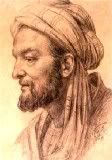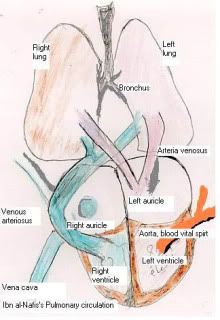However, this was/is not the case. There was a time period, which extended for many centuries where this civilization ruled the earth, not only militarily, but also scientifically. This article is a tribute to the people that have lead to much scientific advancement that is long forgotten. It is, in my opinion, not meant to show Islam in any better light, but rather show the ease with which those people managed to think critically about science, without much hindrance from religion, even though most of them lived almost a thousand years ago, unlike many “modern” religious figures that have no understanding of science, and yet intervene with it every day.
Al-Jahiz (781 A.D- 868 A.D.)

A famous Afro-Arab scholar, of East African descent who was born to a poor family in Basra. He had great knowledge on Greek philosophy, Arabic poetry, Biology, Zoology and pre Islamic Persian history.
Among his most notable contributions, was The Book of Animals (Kitab al-Hayawan). Its an Encyclopedia of seven volumes that described in details more than 350 different Animal species. He advanced and put theories that were cornerstones in the development of the theory of evolution.
"Animals engage in a struggle for existence; for resources, to avoid being eaten and to breed. Environmental factors influence organisms to develop new characteristics to ensure survival, thus transforming into new species. Animals that survive to breed can pass on their successful characteristics to offspring."
He also suggested that different environmental factors were behind the development of certain Animal and Human characteristics such as black skin color.
"[It] is so unusual that its gazelles and ostriches, its insects and flies, its foxes, sheep and asses, its horses and its birds are all black. Blackness and whiteness are in fact caused by the properties of the region, as well as by the God-given nature of water and soil and by the proximity or remoteness of the sun and the intensity or mildness of its heat."
He was also known for his satirical writings, and is considered by many the greatest writer of the ninth century, and one of the best of all time. He advanced most of his knowledge while living in Baghdad and died in Basra on 868 AD.
Al-Khwarizmi (780-850 AD)

A famous Persian Islamic mathematician and astronomer. He was the writer of the famous book called Al-Jaber, which is the term that derived what you would readily recognize as “Algebra”. Thus he is considered the father of algebra.
His use of systemic thinking for solving linear and quadratic equations were the very foundations of algebra as we know it today, and shaped many other facets of science.
His other major contribution was in the area of Geography. He wrote the “Book on the appearance of the Earth”. The book opens with the list of latitudes and longitudes, in order of "weather zones", that is to say in blocks of latitudes and, in each weather zone, by order of longitude. He also assisted in the construction of a world map for the caliph al-Ma'mun and participated in a project to determine the circumference of the Earth, supervising the work of 70 geographers to create the map of the then "known world".

He lived most of his life in the eastern part of the Persian territory now part of Uzbekistan.
Ibn Seena: (980-1037 A.D.)

Also known by his Latin name “Avicenna”. He was a Persian Muslim and was known to be the foremost Physician and Philosopher of his time. He was born in Persia around 980 in Afshana, in Bukhara province, his mother's home, a small city now part of Uzbekistan.
Ibn Seena is regarded as the father of early modern medicine. His most major contribution was “The Canon of Medicine”. It was considered a standard medical textbook in many Islamic and European Universities up until the early 19th century. His contributions include his discovery of the contagious nature of infectious diseases, the introduction of quarantine to limit the spread of contagious diseases, the introduction of experimental medicine, evidence-based medicine, clinical trials, randomized controlled trials, efficacy tests, clinical pharmacology, neuropsychiatry, risk factor analysis, and the idea of a syndrome, and the importance of dietetics and the influence of climate and environment on health. He is also considered the father of the fundamental concept of momentum in physics, and regarded as a pioneer of aromatherapy.
His main other significant contribution was to philosophy. He was the founder of Avicennian logic and the philosophical school of Avicennism, which were influential among both Muslim and Scholastic thinkers. Ibn Seena was also a pioneer in Physics. He was the first to employ air thermometer to measure air temperature. In addition, he put down an elaborate theory of motion.
Most of his works were written in Arabic - which was the de facto scientific language of that time.
Ibn al-Nafis:(1213-1288 A.D.)

He was an Arab and a Muslim physician, anatomist, physiologist, surgeon, ophthalmologist. He was born in 1213 in Damascus, Syria. He grew up in a time of political turmoil in Syria and Egypt, during the Crusades and Mongol invasions. He attended the Medical College Hospital "Bimaristan al-Noori" in Damascus. He worked at the Al-Nassri Hospital, and subsequently at the Al-Mansouri Hospital, where he became the "Chief of Physicians".
Ibn al-Nafis is most famous for being the first physician to describe the pulmonary circulation, and the capillary, and coronary circulations, which form the basis of the circulatory system, for which he is considered the father of circulatory physiology and "the greatest physiologist of the Middle Ages”.

Abu al-Qasim al-Zahrawi: (936 - 1013 A.D.)

Known in the west as Abulcasis, was an Andalusian-Arab physician, surgeon. Abu al-Qasim was born in the city of El Zahra, six miles northwest of Córdoba, Spain. He lived most of his life in Córdoba. It is also where he studied, taught and practiced medicine and surgery until shortly before his death in about 1013 A.D.
He is considered the father of modern surgery, and one of the greatest medieval surgeons. Al-Qasim was a surgeon and specialized in curing disease by cauterization. He also invented hundreds of devices used during surgery that were described extensively in his book “Al-Tasrif” (The Method of Medicine). Many of the redesigns of his tools are used in the operation room till this day. His use of catgut for internal stitching is still practiced in modern surgery.

The street in Cordoba where he lived is named in his honor as "Calle Albucasis". On this street he lived in house no. 6, which is preserved today by the Spanish Tourist Board with a bronze plaque (awarded in January 1977) which reads:
"This was the house where lived Abul-Qasim."
Ibn al-Haytham:(965 – 1039 A.D.)

Also known in the West as Alhacen or Alhazen, he was an Arab Muslim polymath who made significant contributions to the principles of optics, ophthalmology and medicine. Ibn al-Haytham was born in 965 in Basra, and was educated there and in Baghdad, Iraq, then under the rule of the Buyid dynasty of Persia, and died in Cairo, Egypt.
Ibn al-Haytham was a pioneer in optics, ophthalmology and physics. His pioneering work on number theory, analytic geometry, and the link between algebra and geometry, influenced many well known Western scientists, such as Isaac Newton’s Calculus. Ibn al-Haytham's most famous work is his seven volume treatise on optics, "Kitab al-Manazir" (Book of Optics), which has been ranked alongside Isaac Newton's Philosophiae Naturalis Principia Mathematica as one of the most influential books in physics. Ibn al-Haytham laid the very foundations of the scientific method. This included observation, statement of problem, formulation of hypothesis, testing of hypothesis using experimentation, analysis of experimental results, interpretation of data and formulation of conclusion and publication of findings. Among his other achievements, Ibn al-Haytham gave the first clear description and correct analysis of the camera obscura.
This concludes this article, but definitely does not do justice to the scores of Arab and Muslim scholars and scientists who I failed to mention in this attempted glimpse at history. Hopefully, and depending on time constraints, I would write more articles about other equally worthy names, that would include 5 in each article. Thanks for reading.

No comments:
Post a Comment